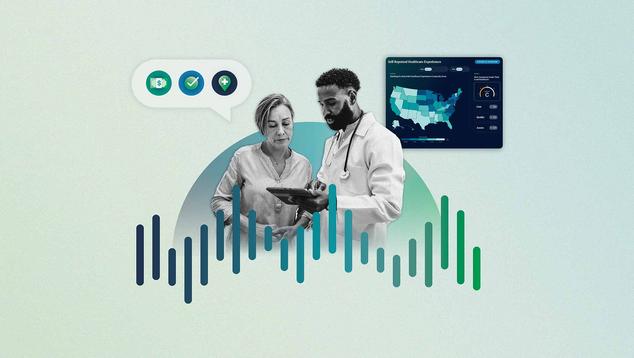Editor's Note: The research below was conducted in partnership between West Health and Gallup.
WASHINGTON, D.C. — Nearly half of U.S. adults (47%) are worried they won’t be able to afford necessary healthcare in the coming year, the highest level of concern recorded since West Health and Gallup began tracking the measure in 2021. One in five Americans — also a record high — report that they or someone in their household couldn’t pay for prescription medications in the past three months. These are merely two of countless healthcare hurdles Americans face.
Millions of Americans are confronting growing challenges to their health and financial wellbeing. The inaugural study, State of the States 2025: Insights on Healthcare in America, from the recently launched West Health-Gallup Center for Healthcare in America, reveals that negative healthcare experiences are widespread in the U.S. but also differ significantly, depending on where people live. The new study offers a comprehensive picture of healthcare across all 50 states and the District of Columbia (D.C.), uncovering dramatic differences in how Americans across the nation experience healthcare in terms of cost, quality and access.
The State of the States 2025 study ranks each state’s performance for its residents’ overall healthcare experiences, derived from responses to 27 questions answered by nearly 20,000 Americans nationwide. In addition to overall rankings, states were evaluated separately on key dimensions of the healthcare experience — cost, quality and access.
Iowa and Massachusetts topped the charts for overall healthcare experience, ranking among the top 10 states for healthcare cost, quality and access. Meanwhile, Alaska, Arkansas and Texas showed consistently poor performance across all areas.
View the full rankings here and learn more about how the West Health-Gallup Center on Healthcare developed the state rankings here.
Residents in the 10 top-ranked states are less likely than those in the 10 bottom-ranked to forgo recommended care (25% compared with 40%) or prescriptions (15% compared with 29%) due to cost. Americans in the top-ranked states are also more likely to report receiving high-quality, proactive care from their providers and to experience fewer barriers to accessing healthcare services, including challenges related to finding providers, transportation, and personal health or mobility limitations.
Despite the clear differences between top- and bottom-ranking states, Americans’ reports show that in every state, thousands — if not millions — of residents are struggling to get the care they need. Given these nationwide systemic challenges, every state, regardless of ranking, has a responsibility to strengthen healthcare delivery.
Rankings Reveal Pain Points and Priorities for Deeper Understanding
Ranking states on healthcare cost, quality and access separately reveals that strong performance in one area doesn’t always translate to strength across the board. While states like Massachusetts, Iowa and Virginia rank in the top 10 overall and in each category, others — such as Nebraska, North Dakota and Pennsylvania — perform well overall but reveal gaps in specific areas. Their uneven performance highlights inconsistencies that can affect residents’ ability to navigate and afford the care they need, despite strengths in other areas of the system.
Comparing states that rank high versus low on cost, quality and access reveals substantial gaps in residents’ ability to obtain the high-quality, affordable care they need. Highlights in the findings include:
Healthcare Cost: High Performers Minimize Financial Strain
- Nationally, about one in five adults (20%) report that someone in their household was unable to afford a prescription in the past three months. In Mississippi, this percentage is 36%, three times the rate in Iowa (12%).
- 30% of U.S. adults say a household member skipped medical treatment due to cost. In Massachusetts, that share is 18% — less than half the rate reported in Mississippi (46%).
Healthcare Quality: Top States Deliver More Proactive Care
- Nationwide, 71% of adults say their healthcare provider ensures they receive all recommended screenings and evaluations. That rate climbs to 78% in Massachusetts and Rhode Island but drops to 59% in Oregon and Wyoming.
- 72% of U.S. adults report that their providers offer guidance on healthy lifestyle choices, such as diet and exercise. In Rhode Island, that figure reaches 80%, compared with 63% in Texas.
Healthcare Access: Fewer Access Barriers in Top-Ranked States
- 25% of U.S. adults say not knowing how to find a provider delayed or prevented care, and that number is 14% in Iowa but is as high as 36% in New Mexico.
- Long wait times for appointments were the most commonly reported barrier nationwide, preventing or delaying healthcare access for 53% of Americans overall. In Vermont, more than two-thirds of residents (72%) cite this issue, compared with just 46% in Nebraska, the top-ranked state.
Healthcare Report Card Shows Disappointing Grades in U.S.
As a part of State of the States 2025, Americans were also asked to grade their local healthcare system overall, and then separately, the cost, quality and access. In sum, Americans gave the nation a C for the overall healthcare system, with healthcare quality and access receiving slightly better marks (C+), while the cost of healthcare rated lowest — a D+. Across the country, not a single state received an A grade for overall healthcare or its cost, quality or access.
Even among states that rank in the top 10 for healthcare experiences, residents still generally rated their systems in the “satisfactory” (C) or “poor” (D) range, demonstrating that while high-performing states may offer valuable lessons, every state has significant room for improvement in delivering on the healthcare quality, access and affordability Americans need. [View the report card for every state here.]
Implications
The West Health-Gallup Center State of the States 2025 offers one of the most comprehensive views to date of how Americans experience healthcare in all 50 states. Building on years of collaborative research between West Health and Gallup, this year’s findings delve deeper into the impact of healthcare costs by presenting, for the first time, insights that are representative at the state level. Understanding these state-level differences is critical for policymakers aiming to address the growing challenges in healthcare access, affordability and quality.
The recent federal government shutdown, fueled partly by healthcare policy disputes, underscores the human impact and urgency of grounding policy decisions in real-world experiences. The stakes in these debates are high for Americans, potentially costing households hundreds — or even thousands — of dollars each year. This comes at a time when Americans’ inability to pay for care is at its highest point since West Health and Gallup began asking about it in 2021, and millions are already burdened by medical debt. The shutdown also underscores the instability of federal policy and funding, highlighting the value of state-level insights to guide dialogue regarding local action to address healthcare cost, quality and access.
This analysis shows the common struggle, that all states — even those at the top — have room for improvement: One in four Americans living in top-10-ranked states report skipping recommended healthcare due to cost, and over 20% report it is difficult or very difficult to access the healthcare services they need. Yet, high-performing states demonstrate ways to better deliver on their promise, offering models for others to follow.
As the U.S. grapples with rising costs, uneven access and persistent quality gaps, the West Health-Gallup Center will continue to offer fresh insights about how Americans are navigating these issues, providing a roadmap for meaningful improvements nationwide.
Full data from State of the States 2025 are available at the newly launched West Health-Gallup Center on Healthcare, a digital hub featuring 20 years of data on the American healthcare experience.
Stay up to date with the latest insights by following @Gallup on X and on Instagram and @West Health on X and LinkedIn.




